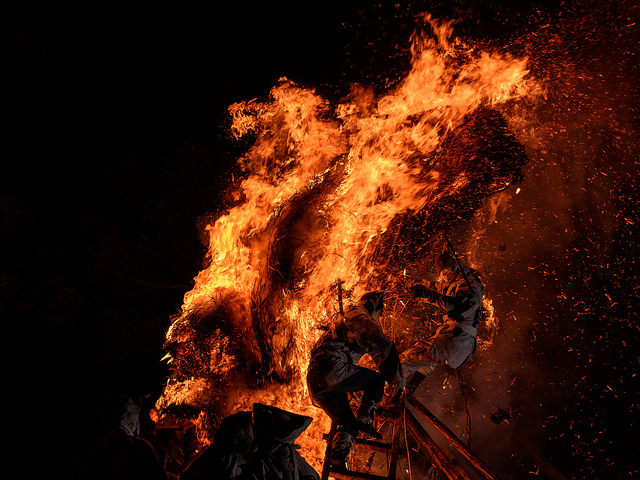Jan 28, 2019
Things are Hotting up at Toba no Himatsuri Fire Festival

Aichi sees a fair number of harvest festivals around the start of the Chinese New Year, with communities praying that their crops in the coming year will be bountiful and generous. However, very few of them are quite as, without wanting to seem disrespectful, terrifyingly crazy as The Toba no Himatsuri, also know as Toba Dai-kagaribi, or The Great Bonfire of Toba.
What is Toba no Himatsuri?
The Toba no Himatsuri, held in Toba in the Aichi city of Nishio, has a history spanning back some 1,200 years, and has in that time been used to predict the year’s harvest as well as the predominant weather for the coming year.
Preparations for the festival, traditionally held on the seventh day of the Chinese Year’s first month (though now on the second Sunday of every February), begin the day before, when locals build two giant torches of sun-dried kaya grass and sixty rods of fresh bamboo that stand some five meters high and weigh approximately two tonnes.
Around these torches, called ‘suzumi’, are wrapped twelve ropes to symbolize the months, and inside is placed ‘shingi’ holy trees, before the two suzumi are placed in the center of Toba Shinmeisha shrine.
What happens at Toba no Hi Matsuri?
On the day of its festival itself, two teams of local men are formed, with those coming from the east area of the Toba River being called ‘Kanchi’ and from the west, ‘Fukuchi’. Amongst each team is one 25 year-old man who is designated the shin-otoko (god man) and his ‘kamio’ ministers, and the festival is begun at the shrine, with the shin-otoko being blessed by the shinto priests.

Then, the two shin-otoko and their kamio, dressed in nothing but loincloths, head to the icy river to cleanse themselves in preparation for the main event: the lighting of the torches.
As night falls, the two immense suzumi are ignited, and protected only by the prayers that have been given to their clothing, the shin-otoko and kamio climb ladders and hurl themselves into the flaming torches, risking serious injury – or worse, with the intention of rescuing the shingi holy tree and as many of the ropes as they can.
Once the death-defying ritual is complete, a score is taken to see which team has collected the most sacred apparatus. If the Kanichi (福地: 福 means happiness or fortune) team wins then the mountainous harvest will be bountiful, but if the Kanko (乾地: 乾 means dry) team win, there will be droughts or natural disasters.
After the count the shingi are taken to the shrine as an offering. It is believed that if chopsticks are made of the shingi, then those who use them will not suffer from tooth-related disease, and if they are crafted into tools for sericulture, then the silk yield will be large.
Toba no Himatsuri Details
When: Second Sunday of February (February 17, 2019). Blessings begin at 15:00. Cleansing in the river is at 15:30. Torches are lit at 20:00.
Where: 89, Toba-cho Nishio (map)
Getting there: Toba Shinmeisha shrine is approximately 10 minutes walk from Mikawa Toba station on the Meitetsu Nishio-Gamagori line
Website: katch.ne.jp
Mark Guthrie
Image: by tohsuke minatoya via flickr.com (CC BY-SA 2.0) -Modified
Image: by 1192_tenugui via flickr.com (CC BY-SA 2.0) -Modified
Image: by hitoshi ozaki via flickr.com (CC BY-SA 2.0) -Modified



About the author